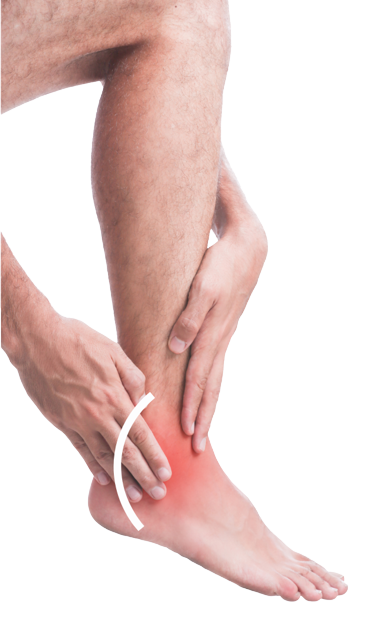Achilles Tendonitis
About Achilles Tendonitis
The Achilles tendon connects your heel bone to your calf and is the largest and strongest tendon in the human body. Named after the Greek god Achilles, the Achilles tendon helps you walk, run and jump by raising the heel off the ground.

What Causes Achilles Tendonitis?
Achilles Tendonitis is the acute inflammation of the tendon due to excessive use. It can be caused by mechanical or non-mechanical factors.
Mechanical Factors
Running related sports
Direct Trauma
Obesity
Non-Mechanical Factors
Muscle Weakness, Imbalance or Lateral instability of the ankle
Medical conditions
Gender and Age
Symptoms Of Achilles Tendonitis
Heel pain
Achilles Tendonitis usually results in heel pain and can be severe in the morning. The pain can also occur anywhere along the tendon’s path, from the heel up to the calf, it is improved somewhat with motion but worsens with increased activity.
Stiffness
The area is likely to feel tender, swollen and stiff due to the inflammation.
Limited range of motion
When Should I Seek Medical Attention?
You should seek medical help when:
- Pain or stiffness at the back of the heel
- Mild aches at the back of the heel
- Tenderness near the affected area
- Pain in the middle of the tendon. Associated with swelling and oedema
- Limited Range of motion
A Message About Achilles Tendonitis
Long-standing heel pain arising from Achilles Tendonitis can result in tears and rupture of the Achilles Tendon (AT). Pain is the first sign of injury. Further aggravation of the tendonitis will result in microtears and subsequently a gap in the tendon. Once that happens, you will lose the ability to run, jump or tiptoe. When there is a complete tear or rupture of the AT, surgical repair is often needed to sew and appose the frayed ends together. The post recovery is long drawn up to 4 – 6 months of keeping the ankle flexed in a cast.
Early intervention with Myospan PRP injection is helpful to reverse the inflammation and early tears. Combined with adequate muscle relaxation to reduce the tension of the AT at night, giving it adequate rest, relaxation and recovery of the overused tendon.
Diagnosing Achilles Tendonitis
Here at Singapore Paincare, our team of experienced primary care physicians and pain care specialists will conduct a thorough diagnosis. This includes a physical exam, questions about your symptoms and an evaluation of your medical history. An X-ray, MRI or CT scan may be needed to evaluate or confirm the degree of Achilles tendinitis.
What Treatments Are Available for Achilles Tendonitis?
At Singapore Paincare, we strive to treat your pain with the least invasive option possible after accurately identifying the cause. Our approach to pain resolution focuses on the removal of pain generators via specialised injection and minimally invasive procedures. Combined with pharmacological treatments and cognitive and physical rehabilitative therapies, we help patients improve functions and prevent pain from recurring.
Non-Surgical Treatments for Achilles Tendonitis
Orthotics
Physiotherapy
Non-steroidal anti-inflammatory drugs (NSAIDs)
Over-the-counter or prescription pain medications can relieve pain and inflammation.
Myospan PRP injection
Injecting PRP can help reduce pain and swelling in the inflamed bursa and the tendinitis. Early treatment is important to prevent tears or rupture from occurring.
Extracorporeal shock wave therapy
Surgical Treatments for Achilles Tendonitis
Sometimes, Achilles Tendonitis may be severe enough to cause a partial tear or rupture, this may require surgery to fix the damaged tendon. As surgery always comes with associated risks, complications and downtime – it may not be suitable for everyone.
Foot surgery
How Can I Prevent Achilles Tendonitis?
Reduce your risk of Achilles tendonitis by:
- Doing a proper warm-up before engaging in any exercise or sports
- Having a variety of exercises to avoid repetitive stress in the Achilles tendon
- Keeping your muscles active
- Wearing proper shoes that fit well
- Avoid running uphill or on uneven ground
Get Your Pain Resolved
Send your enquiries or consult our pain experts today.


